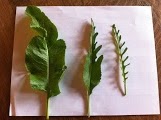Look at this photo and tell me from how many different plants you think I took these leaves.
Well, if you are behaving like I expect you to, you should say “three” because these are three very different looking leaves, one with an intact surface, the next showing some lobing at the tip, and the third a tremendously indented, fingery thing. Well, to my amazement, and hopefully to yours, I picked all three of these leaves from one horseradish (Armoracia rusticana, syn. Cochlearia armoracia) plant in my garden the other day. Because it seemed so absurd that three such different leaves could exist on the same plant, I had to do some looking into the matter, for, wanting a legitimate horticultural explanation, I was about to invest in a Geiger counter and start wearing a lead garden apron. What I found out confirms other observations I’ve made over the years and suggests a strategy to manipulate plants to make them more marketable. Plus I don’t think I need the lead apron.
Consulting the ever-all-knowing internet for some guidance, I first found this:
Hibiscus don’t react well to stress. They show all signs of stress in the leaves, by dropping them or their changing shape. From what I have read, their DNA is not very stable. I had a tropical once that had red double flowers, regular teardrop shaped leaves. After a freeze, it came back out with tri-lobed leaves and single flowers. Especially with the hybrids, there is a tendency to revert to one of the original parent’s characteristics after a severe stressing event.
Quite interesting, I thought, but since I have a suspicion of the information found on these forum-style sites, I dug a bit deeper. A scientific paper came up (and I mean scientific…I was bored by the time I reached the end of the title!), but luckily the abstract quickly confirmed that under stress eucalyptus trees can change the spatial orientation of new leaves. So here I had two promising leads, from two very different species, signaling that leaves were a bit more malleable than I had thought. Finally the clincher came from Hungary, I think. In a brilliant article written in admirably clear English the authors (whose names I cannot even accurately represent because I lack the appropriate keys on my computer) hand over the key insight that explains the horseradish hijinks: PHENOTYPIC PLASTICITY.
Yes, you heard that right. Phenotypic plasticity. A phenotype, as I understand it, is the expression of an organism’s hidden genetic code, which is called its genotype. A plant’s visible leaf shape (phenotype) is an expression of its deeper genetic architecture (genotype), but it seems that at least as far as plants go, there is something of a poker game going on and not all genotypic cards are on the phenotypic table. During times of stress, plants apparently have some “stress-shaped” leaves in their back pockets to play when the game is not going their way. The horseradish above manifested the very thin, deeply-lobed leaves only AFTER I had been hacking away at the soil with a shovel to extract some of its roots to make….well, horseradish, of course! Somehow these stress-shaped leaves represent an advantageous response to the stress conditions, but they are non-permanent, allowing the plant to switch back to more typically-shaped leaves when normalcy resumes.
A few years ago I was talking with a farmer friend, and she mentioned that they had been selling “second-cut” mustard greens to chefs for a premium price. Why second cut? Wouldn’t first-cut have been the premium stuff? Well, it turns out that phenotypic plasticity was rearing its very useful head here, and now I understand why the second cut was more sought-after. After a whole-plant hacking (leaving the roots intact) a mustard like Mizuna will put up a second set of leaves that are generally more delicate and fine-looking than the first. Their response to stress actually is an aesthetic value-add on the dinner plate. Who knew?
Of course I can’t help wondering what else plants, and other creatures, for that matter, can alter when circumstances dictate, but I’m not going to lapse into humanistic psychology here and start gushing about the hidden potential that we all have when times get tough. I’m just going to stand in front of that horseradish in awe over its wonderfully diverse leaf shapes.

